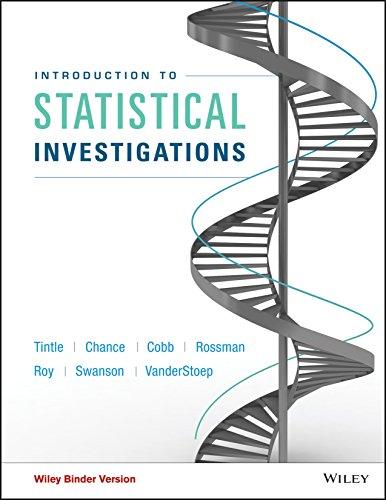Recall the study about anchoring from Exercise 6.2.16, in which students estimated the population of Milwaukee after
Question:
Recall the study about anchoring from Exercise 6.2.16, in which students estimated the population of Milwaukee after some had been told about Chicago and others about Green Bay.
a. Describe in words the parameter(s) of interest in the context of this study.
b. In the context of the parameter(s) described in part (a), express the null and alternative hypotheses for testing whether the class data give strong evidence in support of the anchoring phenomenon described above. If you use symbols, make sure to define them.
c. Check whether the conditions for the validity of the theory-based t-test to compare two means are satisfied here.
d. Use appropriate technology (an applet or a statistical software package) to conduct a t-test of significance of the hypotheses that you stated in part (b). Report the test statistic and p-value.
e. State your conclusion in the context of the study, being sure to comment on statistical significance.
f. Determine and interpret the 95% confidence interval using a theory-based approach for the parameter(s) of interest in the context of the study.
g. Comment on causation and generalization for this study.
Data from 6.2.16
Anchoring is “the common human tendency to rely too heavily, or ‘anchor,’ on one trait or piece of information when making decisions.” (Source: Wikipedia.) A group of students taking an introductory statistics course at a four-year university in California were asked to guess the population of Milwaukee, Wisconsin. Some of the students were randomly chosen to be told that the nearby city of Chicago, Illinois has a population of about 3 million people, while the rest of the students were told that the nearby city of Green Bay, Wisconsin, has a population of about 100,000. Previous studies have shown that these numbers serve as a psychological anchor, so people told about Chicago tend to guess a higher population for Milwaukee than people told about Green Bay. (For more about this phenomenon, see the book Nudge: Improving Decisions about Health, Wealth, and Happiness by Richard H. Thaler and Cass R. Sunstein.) The purpose in analyzing the data is to see if we find strong evidence of this phenomenon among students like the ones in this study.
Step by Step Answer:

Introduction To Statistical Investigations
ISBN: 9781118172148
1st Edition
Authors: Beth L.Chance, George W.Cobb, Allan J.Rossman Nathan Tintle, Todd Swanson Soma Roy





